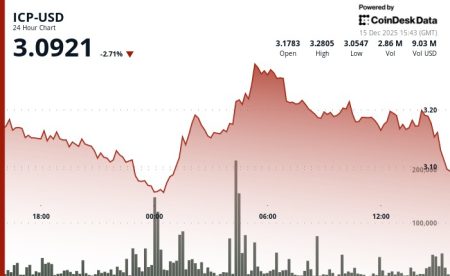SWIFT Embarks on Blockchain Transformation with Linea Messaging Pilot
Global Banking Network Tests Ethereum Layer-2 Technology with Major Financial Institutions
The global financial infrastructure is on the cusp of a significant evolution as SWIFT, the backbone of international banking communications, advances its blockchain integration strategy. In a pioneering initiative, the financial messaging network has partnered with more than a dozen leading banks to test on-chain messaging capabilities using Linea, an Ethereum layer-2 platform developed by ConsenSys. This collaboration represents a potential watershed moment for traditional finance’s adoption of blockchain technology and signals SWIFT’s commitment to modernizing cross-border payment systems.
Financial powerhouses including BNP Paribas and BNY Mellon have joined the initiative, which extends beyond messaging to explore settlement token functionality similar to stablecoins. An insider from one participating bank described the project as potentially marking “a technological transformation for the international interbank payments industry,” though they cautioned that several months of development lie ahead before conclusive outcomes emerge. The significance of this pilot cannot be overstated—SWIFT currently connects more than 11,000 financial institutions worldwide, facilitating the transmission of payment instructions through a centralized model that critics have long argued introduces unnecessary complexity and delays to global transactions.
Blockchain Technology Promises to Streamline Global Financial Messaging
The current SWIFT system, while robust and trusted, relies heavily on intermediaries and legacy infrastructure that can impede transaction efficiency. The Linea pilot aims to determine whether blockchain technology—specifically Linea’s zero-knowledge rollup architecture—can deliver the speed, scalability, and security required for institutional financial messaging while maintaining regulatory compliance. Zero-knowledge cryptography offers particularly compelling advantages for financial institutions, providing transaction verification without exposing sensitive information, thus potentially addressing both privacy concerns and regulatory requirements simultaneously.
This latest initiative builds upon SWIFT’s growing portfolio of blockchain experiments and integrations. Recently, the network announced enhanced rules for retail cross-border payments designed to increase transaction speed and predictability—a move that complements its blockchain strategy. Further demonstrating its commitment to digital asset infrastructure, SWIFT has revealed plans for global banks to conduct live digital asset transactions on its network beginning in 2025. Previous successful pilots have already demonstrated blockchain interoperability, with UBS and Chainlink collaborating with SWIFT to complete tokenized asset transfers across various platforms. The network has also explored broader frameworks for global digital asset transactions and evaluated potential integration with specialized blockchain systems like the XRP Ledger.
Enterprise-Ready Infrastructure Meets Traditional Finance
Linea has positioned itself as an ideal blockchain environment for traditional financial institutions, having launched its native token earlier this year to support a decentralized finance ecosystem valued at approximately $72 billion. Its enterprise-focused design prioritizes the compliance and scalability requirements essential for banking applications, making it a logical partner for SWIFT’s institutional blockchain initiatives. The platform’s architecture allows for faster transaction processing while maintaining the security guarantees of the Ethereum mainnet—characteristics that address key concerns among financial institutions evaluating blockchain adoption.
During a recent industry panel, SWIFT executives offered insights into both the Linea pilot and the broader shift toward digital assets in institutional finance. Tom Zschach, a senior SWIFT executive, emphasized that the industry has progressed beyond the experimental phase: “We’re beyond experiments now. The question is how to scale—regardless of whether the instrument is a tokenized deposit, a CBDC, a stablecoin, or a tokenized fund. It comes down to what exactly we’re connecting and where the value shows up.” This statement reflects a maturing perspective within traditional finance, acknowledging that blockchain technology has demonstrated its viability and that implementation challenges now center on integration and scaling rather than proof of concept.
Legal Certainty Remains Critical for Blockchain Settlement Adoption
While blockchain messaging offers compelling benefits including enhanced settlement efficiency, programmability, and transparency, significant hurdles remain before widespread adoption becomes feasible. Financial institutions face substantial integration costs, operational risks, and regulatory considerations regarding token issuance and transaction data management. Perhaps most critically, legal certainty emerges as a fundamental requirement for blockchain settlement to gain traction in institutional finance. As Zschach aptly noted, “Settlement is a legal construct, not a technical one. We need to align a blockchain’s confirmation model with legal finality. Without that alignment, scaling will be difficult.”
This observation highlights the essential distinction between technical transaction confirmation and legally recognized settlement finality—a gap that cannot be bridged through technology alone. For blockchain settlement to achieve mainstream adoption in global finance, industry standards, comprehensive rulebooks, and clear jurisdictional frameworks must be established to ensure on-chain transactions receive appropriate recognition in courts of law. These legal and regulatory considerations may ultimately prove more challenging than the technical implementation of blockchain messaging systems, requiring coordinated efforts across multiple stakeholders including financial institutions, technology providers, regulators, and legal authorities.
SWIFT’s Blockchain Strategy Signals Broader Financial Infrastructure Evolution
The Linea messaging pilot represents a strategic component of SWIFT’s broader efforts to align its infrastructure with emerging digital asset markets and maintain its central position in global financial communications. While complete adoption of blockchain technology for interbank messaging remains uncertain, the initiative clearly signals SWIFT’s recognition that distributed ledger technology will play a significant role in the future of financial infrastructure. The outcome of this pilot could substantially influence whether blockchain becomes embedded in global interbank communication as a complementary technology or potentially as a replacement for certain aspects of traditional messaging systems.
Financial institutions worldwide are watching this development closely, recognizing that SWIFT’s approach to blockchain integration may establish precedents for the broader industry. By partnering with established banks and leveraging enterprise-grade blockchain solutions like Linea, SWIFT is pursuing a measured approach that balances innovation with the stability requirements of global financial infrastructure. As traditional finance and blockchain technology continue their convergence, initiatives like the Linea messaging pilot provide valuable insights into how these distinct paradigms can be harmonized to create more efficient, transparent, and resilient financial systems. The coming months will prove critical in determining whether this particular implementation delivers sufficient benefits to justify wider adoption across SWIFT’s extensive network of financial institutions.














